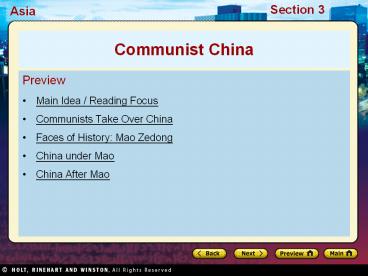Preview - PowerPoint PPT Presentation
1 / 17
Title:
Preview
Description:
Communist China Preview Main Idea / Reading Focus Communists Take Over China Faces of History: Mao Zedong China under Mao China After Mao Improvements in literacy ... – PowerPoint PPT presentation
Number of Views:40
Avg rating:3.0/5.0
Title: Preview
1
Communist China
- Preview
- Main Idea / Reading Focus
- Communists Take Over China
- Faces of History Mao Zedong
- China under Mao
- China After Mao
2
Communist China
Main Idea China has undergone many changes since
becoming a Communist nation in 1949. today, after
making many market reforms, China has a rapidly
growing economy.
- Reading Focus
- How did the Communists take over China?
- What were the main events that took place in
China under Maos leadership? - How did China change in the years after Maos
death?
3
Communists Take Over China
During World War II the Chinese Communists and
the nationalist Guomindang put aside differences
to fight Japanese invaders.
4
Communists Take Over China
5
(No Transcript)
6
Summarize Why did peasants support the
Communist takeover of China?
Answer(s) because the Communists promised them
land
7
China under Mao
Having defeated the Guomindang, Mao set about
building a Communist China. His first concern was
rebuilding a country that had been torn apart by
years of civil war.
8
Early Years
- Improvements in literacy rates, public health
- Chinese life expectancy increased sharply over
next few decades - Improvements came at a cost
- To consolidate Communist control over China,
government soon began to eliminate so-called
enemies of the state who had spoken out against
governments policies - Many thousandsincluding public officials,
business leaders, artists, writerskilled, or
sent to labor camps
9
- China Modeled on Soviet Union
- Soviet Union provided financial support, aid in
Chinas first years - China modeled many of its new political,
economic, military policies on Soviet system - 1950s, territorial disputes, differences in
ideology pushed China away from Soviet ally
- The Great Leap Forward
- 1958, in break from Soviet-style economic
planning, Mao announced program designed to
increase Chinas industrial, agricultural output - The Great Leap Forward created thousands of
communes, collectively owned farms, of about
20,000 people each - Each commune to produce food, have own
small-scale industry
10
The Great Leap Forward
11
The Cultural Revolution
- New Movement
- Mid-1960s, Mao tried to regain power, prestige
lost after Great Leap Forward - Initiated new movement called Cultural
Revolution, sought to ride China of old ways,
create society where peasants, physical labor
were the ideal
- Red Guards
- Campaign meant eliminating intellectuals who Mao
feared wanted to end communism, bring back
Chinas old ways - Mao shut down schools, encouraged militant
students, Red Guards, to carry out work of
Cultural Revolution by criticizing intellectuals,
values
- Destruction of Society
- Mao lost control Red guards murdered hundreds of
thousands of people by late 1960s, China on
verge of civil war before Mao regained control - Cultural Revolution reestablished Maos
dominance, caused terrible destruction civil
authority collapsed, economic activity fell off
sharply
12
Analyze How did life in China change under Mao?
Answer(s) The failure of the Great Leap Forward
and the isolation of China triggered the Cultural
Revolution.
13
China After Mao
- Reforms Begin
- 1976, Mao died his death followed by retreat
from many of his policies - China began to end isolation from rest of world
in early 1970s - 1972, U.S. President Richard Nixon visited China,
meeting with Mao - During last years of Maos life, much power
wielded by group of four people known as Gang of
Four
14
Tiananmen Square
- More Freedoms
- Inspired by movement toward economic freedom
- Chinese demanded more political freedom
- Pro-Democracy Protestors
- Spring 1989, democratic reforms in Eastern Europe
- One million pro-democracy protestors occupied
Beijings Tiananmen Square
- Leaders Impatient
- Chinas leaders repeatedly asked protestors to
leave square - Protestors remained, met with force
- Freedom Had Not Arrived
- June 1989, tanks, troops moved into square
- Killed protestors in Tiananmen Square Massacre
15
China Today
Chinas economy has grown rapidly as market
reforms have continued. Today, Chinas economy is
the second largest in the world, behind only the
United States. As the economy has improved, so
has the standard of living for many Chinese.
This has caused shortages and higher costs for
these resources on the global market, as well as
air and water pollution within China.
16
Human Rights Issues
- Human rights abuses another concern for critics
of China - Chinese government continues to limit free
speech, religious freedoms - Exercises strict control over the media
- Political protestors can be jailed
- Nations courts accused of failing to provide
fair trials - Critics increased calls for reforms after Beijing
chosen to host 2008 Olympic Games
17
Make Generalizations How did China change in the
years after Maos death?
Answer(s) isolation lessened, more moderate
leaders took power new economic freedom led to
call for political freedom, improved standard of
living































